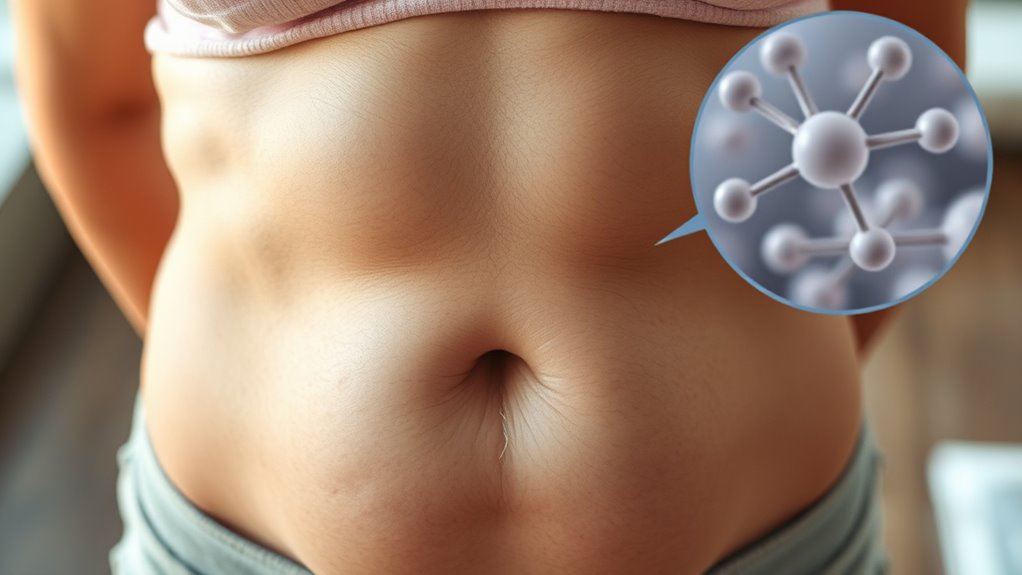After 40, hormonal changes like declining estrogen, progesterone, and testosterone cause your body to store more fat around your abdomen. These shifts slow your metabolic rate and reduce muscle mass, making it easier to gain weight and harder to burn fat. Lifestyle factors also play a role, especially if your activity level or diet isn’t adjusted. To understand how these changes affect you and discover ways to manage belly fat, explore the details ahead.
Key Takeaways
- Hormonal declines, especially in estrogen and testosterone, shift fat storage from hips and thighs to the abdomen.
- Decreased estrogen impairs fat breakdown and promotes visceral fat accumulation around organs.
- Muscle mass loss reduces metabolic rate, leading to increased fat retention, particularly in the belly area.
- Aging decreases fat oxidation and energy expenditure, encouraging fat buildup in the abdominal region.
- Lifestyle factors like reduced activity and poor diet during middle age contribute to increased belly fat.
Hormonal Fluctuations During Middle Age

As you reach middle age, your hormones undergo significant fluctuations that can impact your body composition. Testosterone levels, which peak in your teens and early twenties, start declining around age 30, dropping by about 1-2% each year. This gradual or sudden decrease reduces muscle mass and promotes fat buildup, especially around your belly. You might also notice symptoms like decreased libido, fatigue, and mood swings. Hormonal imbalances can cause weight gain and make losing fat more difficult. Changes in heat and cold sensitivity, excessive sweating, sleep issues, and headaches signal shifts in your hormone levels. These fluctuations affect your metabolism and fat distribution, often leading to increased abdominal fat, which is common in middle-aged men. Incorporating hormonal health strategies can help manage these changes more effectively.
The Impact of Menopause on Body Composition

Menopause brings about significant changes in your body composition, primarily characterized by increased fat accumulation and loss of lean muscle mass. During this changeover, your fat mass can increase 2- to 4-fold, especially around the abdomen, leading to more visceral fat. At the same time, you start losing lean muscle, which impacts strength and metabolism. These shifts begin about two years before your final period and continue afterward, though they tend to stabilize postmenopause. Your energy expenditure and activity levels also decline, contributing to these changes. Variability exists—some women experience weight loss, others gain substantial fat. These alterations raise health risks like cardiovascular disease and metabolic syndrome, emphasizing the importance of managing body composition during menopause.
How Estrogen Decline Promotes Fat Storage

As estrogen levels drop, your hormonal balance shifts, making it easier for fat cells to store fat, especially around your belly. This decline also affects how your fat cells grow and respond to signals, leading to increased fat accumulation in specific areas. With menopause, these changes become more pronounced, promoting a shift toward more central fat storage.
Hormonal Balance Shifts
When estrogen levels decline after 40, they no longer effectively regulate fat distribution, leading to a shift from the hips and thighs to the abdominal area. This hormonal imbalance causes your body to lose its protective subcutaneous fat and accumulate visceral fat around your organs. Here’s what happens:
- Your decreased estrogen reduces fat breakdown in the belly, promoting storage.
- The disruption in energy balance encourages central fat deposition.
- Changes in estrogen receptors impair fat metabolism and insulin sensitivity.
As a result, your body favors male-pattern fat storage in the abdomen, increasing metabolic risks. This shift is driven by hormonal signals that no longer favor healthy fat distribution, making belly fat more persistent after 40.
Fat Cell Regulation
Declining estrogen levels after 40 directly influence how your fat cells store and release fat. When estrogen drops, it affects the regulation of adipocyte metabolism and fat storage patterns. Estrogen interacts with receptors like ERα and ERβ, which help control fat distribution and insulin sensitivity. Lower estrogen shifts fat storage from subcutaneous regions, like hips and thighs, to visceral areas, especially the abdomen. It also impacts signaling pathways, such as mTOR, that govern fat accumulation. Additionally, reduced estrogen influences epigenetic modifications in adipogenic genes, promoting fat cell formation and lipid storage in certain tissues. This disruption favors increased abdominal fat, contributing to a less healthy fat distribution and raising your risk for metabolic issues. Understanding the zodiac sign of your genetic makeup can also provide insights into your body’s response to hormonal changes.
Menopause Transition Effects
During menopause, the drop in estrogen levels causes a significant shift in how your body stores fat, moving from a pattern focused on hips and thighs to one concentrated in the abdomen. This change is driven by estrogen deficiency, which promotes increased visceral and abdominal fat accumulation. As estrogen declines:
- Your body shifts from gynoid (hip/thigh) to android (abdominal) fat distribution, raising health risks.
- Lipid metabolism becomes less efficient, reducing fat breakdown and increasing triglyceride storage in visceral fat.
- Fat oxidation decreases, lowering energy expenditure and encouraging fat buildup, especially around the belly.
- This hormonal shift also affects metabolic health, making it more challenging to lose weight in the midsection. Additionally, lifestyle factors such as diet and physical activity can influence the extent of fat gain during this period.
The Role of Progesterone Changes in Fat Distribution

Although progesterone levels don’t directly cause belly fat to increase, changes in this hormone during menopause can influence overall fat distribution. As you age, progesterone declines, disrupting the hormonal balance that helps regulate fat storage. This imbalance, combined with declining estrogen, shifts fat from hips and thighs to the abdominal area. While progesterone itself isn’t the main factor in belly fat buildup, its reduced levels can contribute to hormonal fluctuations that favor central fat accumulation. Additionally, a drop in progesterone affects muscle tone and metabolism, which can further promote fat retention around your midsection. Moreover, recent advancements in machine learning are being utilized to better understand hormonal interactions and develop personalized treatment plans. These innovative analytical techniques enable researchers and clinicians to identify subtle hormonal shifts that contribute to fat redistribution. Understanding hormonal fluctuations and this hormonal interplay is key to addressing changes in your body composition after 40. For example, AI-driven research is increasingly helping to uncover complex hormonal patterns, leading to more targeted interventions. Incorporating lifestyle modifications such as diet and exercise can also support hormonal balance and mitigate these effects. Managing hormonal balance through lifestyle changes or hormone therapy may help mitigate these effects.
Metabolic Rate Slowdown With Age

As you age, your muscle mass naturally decreases, which lowers your overall calorie burn. This reduction in lean tissue means your body becomes less efficient at burning calories, even at rest. Over time, this slowdown can contribute to increased belly fat if you’re not adjusting your activity and diet. Incorporating strength training can help combat muscle loss and support a higher metabolic rate, which is crucial for maintaining a healthy weight. Additionally, engaging in regular physical activity can help offset the effects of metabolic rate slowdown, promoting better weight management as you age. Building muscle mass through resistance exercises not only enhances strength but also boosts your resting metabolic rate. To further support your metabolism, consider exploring support options like fitness classes or personalized coaching. Moreover, adopting sustainable lifestyle practices that minimize environmental impacts can support overall well-being and long-term health.
Decline in Muscle Mass
A natural part of aging is losing muscle mass, which directly causes your metabolic rate to slow down over time. As you age, you can lose about 3-8% of your muscle every decade after 30, with rates increasing after 75. Each year, both men and women shed roughly half a percent of muscle, and by age 80, you may have lost 35-40% from your 20s. This decline impacts your strength and overall health, making daily activities harder. To picture it:
- You might notice less strength and endurance during physical activity.
- Your body burns fewer calories at rest, leading to easier fat gain.
- Muscle loss reduces energy use, contributing to increased belly fat over time.
- Muscle maintenance is essential not only for strength but also for supporting your metabolic health and preventing further deterioration. Incorporating resistance training can help combat this decline and is supported by scientific research demonstrating its effectiveness. Additionally, a balanced diet rich in protein plays a crucial role in preserving muscle mass as you age.
Maintaining muscle is key to counteracting these effects and preserving your metabolic health. Proper muscle maintenance can help slow this decline and support overall well-being.
Reduced Calorie Burn
Muscle loss is a significant factor in slowing your metabolic rate, but it’s not the only reason your calorie burn decreases with age. Starting around age 60, your total energy expenditure and basal metabolic rate gradually decline, decreasing about 0.7% each year beyond 60. By age 90, your calorie needs can be roughly 26% lower than in middle age. This slowdown isn’t just due to losing muscle; cellular activity itself diminishes with age, reducing energy requirements independently. Even if you maintain muscle, your metabolic rate still drops. Factors like chronic diseases and overall health also influence this decline. Additionally, the horsepower of electric dirt bikes shows how power output can vary, illustrating how energy efficiency decreases with age. As a result, your caloric needs decrease over time, making it essential to adjust your diet and stay active to prevent unwanted weight gain, especially around your belly. Maintaining overall metabolic health through proper nutrition, regular exercise, and cellular efficiency can help mitigate some of these effects. Understanding the biological aging process can motivate lifestyle choices that support metabolic function as you age, including optimizing your headphone setup for better focus and relaxation during workouts or rest.
Why Fewer Calories Are Burned Over Time

Fewer calories are burned over time mainly because your body’s metabolic processes slow down with age. This gradual decline affects how many calories you burn at rest and during activity. Several factors contribute to this slowdown:
- Your basal metabolic rate (BMR) decreases about 0.7% each year after age 60, leading to about 26% fewer calories burned by age 90+.
- Loss of lean muscle mass, which has higher metabolic activity than fat, reduces your resting energy expenditure.
- Hormonal changes, including decreases in testosterone, growth hormone, and thyroid hormones, slow your metabolism and promote fat storage.
- Regular grooming and cleaning routines can help manage excess pet hair, reducing the need for frequent deep cleaning that can contribute to stress and weight gain.
- Additionally, metabolic slowdown is compounded by lifestyle factors such as decreased physical activity and dietary changes that often occur with age.
These combined effects mean your body becomes less efficient at burning calories, making it easier to gain belly fat if you don’t adjust your lifestyle accordingly.
Sedentary Lifestyle and Its Effects on Belly Fat

As your metabolic rate declines with age, staying inactive can further accelerate fat accumulation around your abdomen. Sedentary behaviors like prolonged sitting and watching TV are linked to increased visceral and subcutaneous fat, regardless of physical activity levels. CT scans show that more sedentary time correlates with fat buildup in the abdomen, liver, and muscle tissue, raising metabolic risks. Sitting more than 6 to 8 hours daily is associated with higher total and trunk fat, even if you exercise regularly. This lack of movement decreases energy expenditure and muscle contractions, promoting fat storage, especially in the belly area. Over time, these habits contribute to increased visceral fat, which surrounds internal organs and heightens your risk for metabolic diseases, cardiovascular issues, and premature death.
Decreased Physical Activity in Midlife

As you reach midlife, your exercise frequency often drops, leading to a more sedentary lifestyle. This decline can make it harder to maintain a healthy weight and reduce belly fat. Staying active during this time is essential to counteract these trends and protect your long-term health.
Reduced Exercise Frequency
Reduced exercise frequency during midlife can markedly impact your health by increasing the risk of chronic diseases like diabetes and heart disease. When you skip regular activity, muscle mass declines, weakening your strength and raising fall risk. Your cardiovascular health also suffers, making heart issues more likely. Additionally, physical inactivity accelerates age-related cognitive decline and hampers mobility, reducing your independence.
To picture this, consider:
- You become less physically capable, impacting daily tasks.
- Your risk of developing diabetes or heart problems rises.
- Your overall quality of life decreases, limiting mobility and enjoyment.
Sedentary Lifestyle Trends
Sedentary lifestyle trends have intensified in midlife, largely driven by technological advances and changes in daily routines. You often spend more time sitting during work, leisure, and commuting, with many accumulating prolonged, uninterrupted bouts of 30 minutes or more. Nearly one-quarter of adults are physically inactive outside of work, and global data shows nearly one-third don’t meet recommended activity levels. In the US, sedentary behaviors have remained stable or increased over recent years, with screen time and computer use rising sharply. This increase in sitting correlates with higher risks of chronic diseases and mortality. Factors like age, BMI, seasonal shifts, and environmental influences further boost sedentary patterns. Reducing screen time and increasing movement are essential steps to combat this trend and improve your health.
Sleep Disruptions and Fat Accumulation

Sleep disruptions can markedly contribute to fat accumulation, especially after age 40. When your sleep quality declines or you don’t get enough rest, hormonal shifts occur that promote weight gain. This process involves several factors:
- Increased hunger hormones like ghrelin and leptin, leading to overeating.
- Slowed metabolism, which reduces calorie burning.
- Reduced physical activity due to fatigue, making it harder to stay active.
These effects create a cycle that encourages fat storage, particularly around the belly. Short or disrupted sleep also impacts visceral fat, increasing health risks. Even beyond 8 hours, poor sleep quality can hinder fat loss efforts. Recognizing and improving your sleep patterns is essential to managing belly fat after 40.
Stress Levels and Abdominal Weight Gain

When you’re stressed, your cortisol levels rise, which can lead to more belly fat. Stress often triggers emotional eating, making it even harder to maintain a healthy weight. Plus, stress can disrupt your sleep, further fueling weight gain around your abdomen.
Stress and Cortisol Increase
As stress levels rise, your body responds by producing more cortisol, a hormone that plays a key role in managing metabolism and your stress response. Elevated cortisol prompts your body to store more fat around your abdomen. Here’s what happens:
- Your blood sugar increases, leading to more fat storage, especially in the belly area.
- Hunger and cravings for high-calorie foods spike, encouraging overeating.
- Your metabolism shifts toward fat retention rather than burning it, making stubborn belly fat worse.
Over time, sustained stress and high cortisol levels can make it hard to shed that extra weight. As you age, hormonal changes amplify this effect, increasing the likelihood of a “stress belly” that resists traditional dieting. Managing stress is essential for controlling cortisol and belly fat.
Emotional Eating Triggers
Have you ever noticed how your mood influences your eating habits? When stress hits or you’re feeling down, you might reach for comfort foods—high in sugar and fat—that temporarily soothe your emotions but contribute to belly fat over time. Emotional eating often happens outside regular meals, making it harder to maintain balanced habits. The more you associate food with emotional relief, the more likely you are to develop abdominal weight gain. Here’s a quick overview:
| Trigger | Common Responses | Risks |
|---|---|---|
| Anxiety & depression | Cravings for sweets, snacks | Increased waist circumference |
| Stressful events | Binge-eating, overeating | Higher BMI, metabolic issues |
| Body dissatisfaction | Emotional comfort in food | Greater abdominal fat |
| Mood swings | Excess snacking | Elevated risk of heart disease |
Sleep Disruption Effects
Sleep disruption markedly impacts your stress levels, which in turn promotes abdominal weight gain. Elevated cortisol from poor sleep encourages fat storage, especially around your midsection. It also triggers hormonal changes that increase appetite and calorie intake. To visualize this, consider:
- Short sleep durations raising visceral fat by about 11%, heightening health risks.
- Fragmented sleep and difficulty falling asleep boosting abdominal fat and BMI.
- Late bedtimes disrupting circadian rhythms, leading to increased hunger hormones and unhealthy eating.
All these factors combine, making it harder to shed belly fat after 40. When your sleep quality declines, your body’s ability to regulate hormones and glucose becomes impaired, fueling fat accumulation in your abdomen. Prioritizing good sleep helps break this cycle and supports a healthier waistline.
Genetic Factors Influencing Fat Distribution

Genetic factors play a significant role in shaping where your body stores fat, especially around the abdomen. Your genes influence how much fat you carry overall and specifically where it’s stored, with heritability estimates between 22% and 86%. About 56% of visceral fat, which surrounds your organs, is genetically determined. Fat distribution patterns vary across ethnic groups, with Asians tending to store more abdominal fat and Africans less. Sex also influences fat placement, driven by hormonal differences and sex-specific genes. Your genes interact with lifestyle factors like diet and activity, meaning your environment can amplify or reduce genetic tendencies. Research has identified hundreds of genetic loci linked to fat distribution, highlighting that your genetic makeup plays a vital role in where fat accumulates over time.
The Link Between Stress Hormones and Belly Fat

When you’re stressed, your body releases cortisol, which encourages fat to settle around your belly. Elevated stress hormones disrupt your hormonal balance, making it harder to lose weight and control hunger. Managing stress effectively can help keep cortisol levels in check and support healthier fat distribution.
Cortisol’s Role in Fat Storage
Cortisol, often called the stress hormone, plays a significant role in how your body stores fat, especially around the belly. When stress levels rise, cortisol prompts your body to shift fat from storage areas to abdominal fat cells, increasing visceral fat. This process involves several mechanisms:
- Cortisol encourages growth of fat cells in the abdomen, making them larger and more numerous.
- Higher enzyme activity in visceral fat boosts cortisol production, fueling further fat accumulation.
- Cortisol mobilizes energy by relocating fat stores to the abdomen, promoting central obesity.
Persistent stress keeps cortisol levels elevated, which can lead to increased belly fat and higher health risks. Managing stress and cortisol is essential to controlling abdominal weight gain, especially after 40.
Stress and Hormonal Balance
Stress hormones beyond cortisol, such as adrenaline and norepinephrine, actively influence how your body stores fat, particularly in the abdominal region. Elevated norepinephrine during chronic stress affects fat cell behavior in different ways, often promoting visceral fat buildup. These hormones also impact insulin resistance, making it harder for your body to process glucose, which encourages fat storage around your waist. Additionally, stress hormones alter appetite hormones like leptin and ghrelin, leading to overeating and further fat gain. Hormonal imbalances disrupt your body’s stress response, increasing central adiposity risk. Here’s a snapshot of how these hormones interact:
| Hormone | Effect on Belly Fat |
|---|---|
| Adrenaline | Promotes fat breakdown temporarily |
| Norepinephrine | Alters fat cell activity, favors storage |
| Insulin | Resistance leads to increased fat storage |
Managing Stress for Weight
Managing stress effectively is essential for controlling belly fat, as chronic stress triggers hormonal changes that promote fat storage around your abdomen. When you’re stressed, your body releases cortisol, which encourages fat accumulation in your belly area. Elevated cortisol levels are linked to increased visceral fat, raising your risk for heart disease and diabetes. Psychological factors like poor coping skills and mood reactivity can amplify cortisol secretion, further promoting abdominal fat. To combat this:
- Practice stress-reducing activities like yoga or meditation to lower cortisol.
- Maintain regular exercise routines to manage stress hormones and improve fat distribution.
- Prioritize good sleep, as quality rest helps regulate cortisol levels and curbs fat storage.
Age-Related Changes in Muscle Mass

As you age, your muscle mass naturally declines, with a loss of about 3–8% per decade after your 30s. This decline accelerates after 60, making everyday tasks harder. Think of your muscles like this:
| Age Group | Muscle Mass | Effect |
|---|---|---|
| 30s | Peak | Strength and endurance |
| 40s | Slight decline | Slight reduction in strength |
| 50s | Moderate decline | More noticeable weakness |
| 60+ | Rapid decline | Increased frailty and falls |
Sarcopenia, the technical term for age-related muscle loss, affects everyone. Hormonal changes, such as lower testosterone, make it tougher to build and maintain muscle. Regular strength exercises and proper nutrition can slow this process.
Loss of Muscle and Its Effect on Metabolism

As you lose muscle with age, your metabolism slows down because muscle tissue burns calories even at rest. This means you burn fewer calories daily, making it easier to gain fat, especially around your belly. Without enough muscle, your body becomes less efficient at using energy, which can accelerate weight gain over time.
Muscle Loss Slows Metabolism
When muscle mass decreases with age, your metabolism slows down because muscle tissue is a key driver of energy expenditure. Less muscle means your body burns fewer calories at rest and during activity. This slowdown impacts several areas:
- Reduced calorie burning: Less muscle decreases overall energy expenditure, making it easier to gain weight.
- Insulin resistance: Muscle loss impairs glucose uptake, increasing the risk of metabolic diseases like diabetes.
- Altered lipid metabolism: With less muscle, your body struggles to regulate fats, leading to higher triglycerides and fatty liver risk.
As muscle declines, your body becomes less efficient at burning calories and managing nutrients, contributing to increased belly fat and metabolic slowdown after 40.
Reduced Resting Energy Burn
With age, your resting metabolic rate (RMR) drops considerably, and losing muscle mass plays a major role in this decline. Muscle is more metabolically active than fat, so losing it reduces the calories your body burns at rest. As you age, your activity level and thermic effect of food also decrease, further lowering energy expenditure. Here’s how muscle loss impacts you:
| Muscle Mass | Calorie Burn | Effect on Belly Fat |
|---|---|---|
| Declines | Less energy | Increased fat storage |
| Less muscle | Slower RMR | More abdominal fat |
| Reduced activity | Less NEAT | Higher visceral fat |
| Hormonal shifts | Less maintenance | Belly fat accelerates |
This decline makes it easier to accumulate belly fat and harder to lose it.
Fat Gain Accelerates
Losing muscle mass doesn’t just slow down your metabolism; it also speeds up fat gain, especially around the belly. As muscle declines, your body becomes less efficient at burning calories and processing fats. Over time, this accelerates fat accumulation, making it harder to lose weight. Here’s what happens:
- Muscle loss of about 3–8% per decade reduces your metabolic rate, lowering daily calorie burn.
- About 30% of lifetime muscle is lost, weakening your body’s ability to utilize energy effectively.
- Muscle decline of 1% annually hampers glucose and lipid metabolism, leading to increased fat storage.
Without intervention, this process feeds into a cycle of increased belly fat, making it tougher to stay lean after 40. Resistance exercise and proper nutrition are key to breaking this cycle.
The Transition Through Menopause and Belly Fat

As women go through menopause, hormonal shifts considerably influence how and where your body stores fat, particularly around the abdomen. The decline in estrogen disrupts the hormone’s role in regulating fat distribution, leading to more fat accumulating in the visceral area. This hormonal change also triggers metabolic shifts, slowing down how your body processes and burns fat. As estrogen drops, fat tends to move from under the skin to deeper around your organs, making belly fat more prominent. These shifts often coincide with the end of menstrual cycles, signaling the loss of estrogen’s regulatory effects. Combined with age-related muscle loss and a slower metabolism, these changes make it easier to gain belly fat during this passage, increasing health risks if not managed effectively.
Midlife Weight Gain Patterns

Midlife is often accompanied by noticeable changes in weight, and many women experience a gradual increase during this period. You might notice your weight creeping up, especially around your midsection. Several patterns explain this shift:
Midlife often brings gradual weight gain, especially around the abdomen.
- About 66.3% of women aged 40–59 are overweight or obese, highlighting how common it is.
- On average, women gain 0.4 to 0.7 kg each year, gradually increasing over time.
- There’s often a shift in fat distribution from the hips and thighs to your abdomen, making belly fat more prominent.
This pattern is influenced by hormonal changes, metabolism slowdown, and lifestyle factors. Recognizing these trends helps you understand why your body changes and how to address it effectively.
How Physical Inactivity Contributes to Belly Fat

When you’re inactive, your body burns fewer calories, which can lead to more fat around your belly. Sedentary habits, like sitting for hours, also cause muscle loss, slowing your metabolism further. Over time, this combination encourages the accumulation of visceral fat, increasing health risks.
Sedentary Lifestyle Effects
A sedentary lifestyle substantially contributes to the accumulation of belly fat, especially after 40. When you sit for long periods, your metabolism slows down, making it harder to burn calories efficiently. This can lead to increased fat storage around your abdomen. Here are three ways it impacts you:
- Higher Body Fat: Sitting more than 8 hours daily raises your total and trunk fat percentages.
- Metabolic Disruption: Prolonged inactivity reduces your metabolic rate and promotes insulin resistance.
- Hormonal Imbalance: Sedentary behavior causes hormonal shifts that favor fat storage, especially in the belly area.
Reducing sitting time and staying active can help counteract these effects and support healthier fat distribution as you age.
Muscle Loss and Fat
Physical inactivity accelerates muscle loss, which directly impacts your metabolism and overall body composition. When you don’t move enough, your muscles weaken and shrink, leading to a lower resting metabolic rate. This means your body burns fewer calories naturally, making it easier for fat to accumulate, especially around your belly. As you age, muscle loss naturally occurs, but inactivity worsens this process. The decline in muscle strength also makes physical activity harder, creating a vicious cycle. Regular exercise, particularly resistance training, helps preserve and build muscle mass, boosting your metabolism. Maintaining muscle not only burns more calories but also prevents fat from settling around your midsection. Staying active is essential to counteract age-related muscle loss and reduce belly fat effectively.
The Impact of Poor Sleep on Fat Storage

Poor sleep can markedly increase fat storage, especially after 40, by disrupting the body’s natural metabolic processes. When you don’t get enough rest, your metabolic rate drops, making it harder to burn fat. Plus, poor sleep upregulates your appetite, leading to overeating, especially high-calorie foods. Insulin sensitivity also decreases by about 30%, impairing fat cell function and promoting fat accumulation.
Poor sleep increases fat storage after 40 by disrupting metabolism and appetite regulation.
Here’s how poor sleep affects you:
- It shifts energy use from fats to sugars, favoring fat storage.
- It hampers fat cell response to insulin, reducing glucose uptake.
- It increases hunger hormones like ghrelin and decreases leptin, driving overeating.
All these factors combine to make it easier to gain belly fat after 40, even with diet and exercise.
Medication Use and Its Role in Weight Gain

Many medications you take can contribute to weight gain by affecting hormones and fat storage. Drugs like beta-blockers and certain antidiabetics may alter your metabolism and hunger signals, leading to increased belly fat. Understanding these effects can help you and your doctor make better choices to manage your weight.
Medication-Induced Fat Storage
Medications can substantially influence how your body stores fat, especially after 40. Certain drugs promote fat accumulation through various mechanisms. For example:
- Fluid Retention: Medications like steroids cause water retention, adding to weight gain and abdominal bloating.
- Appetite Stimulation: Some antidepressants and insulin secretagogues increase hunger, leading to overeating.
- Fat Storage Promotion: Drugs such as TZDs and antipsychotics encourage fat deposition, especially in the abdominal region.
These effects often lead to increased visceral and subcutaneous fat, raising your risk for metabolic issues. It’s essential to be aware of how your medications might be contributing to belly fat. Regular monitoring and discussing alternatives with your healthcare provider can help manage these side effects effectively.
Hormonal Effects of Drugs
Medication use can substantially influence hormonal balance, which in turn affects how your body stores and distributes fat. Certain drugs, like beta-blockers, are known to cause weight gain by altering metabolism and hormonal regulation, often leading to increased belly fat. These medications can disrupt insulin sensitivity and hormone levels that control fat storage, especially after 40 when hormonal shifts are already underway. The effects vary depending on the medication, dosage, and your individual metabolism. For example, some antidepressants and antidiabetics can cause weight gain by influencing appetite and metabolic rate. As you age, your body becomes more sensitive to these hormonal changes, making medication-induced fat accumulation around the abdomen more likely. Monitoring your medication and working with your doctor can help manage these effects.
Dietary Choices and Their Influence on Belly Fat

Your dietary choices directly impact belly fat, especially after 40. What you eat can either promote or reduce abdominal fat. For example:
- Consuming more soluble fiber from fruits, vegetables, oats, and legumes increases fullness and lowers calorie absorption, helping prevent fat gain.
- Limiting trans fats found in processed foods reduces inflammation and abdominal fat accumulation.
- Reducing intake of sugary drinks and processed foods with high fructose content minimizes fat storage in your belly.
Focusing on high-fiber, whole foods, healthy fats, and lean proteins supports fat loss. Avoiding trans fats and excess sugar is essential. Small dietary adjustments can markedly influence your belly fat as you age.
High-Calorie Foods and Midlife Weight Gain

High-calorie foods, especially those rich in carbohydrates and fats, play a significant role in midlife weight gain. When you consume too many processed and ultra-processed foods, your calorie intake quickly surpasses your energy needs, leading to fat accumulation, particularly around your belly. Foods with a high glycemic index and load cause spikes in blood sugar and insulin, promoting fat storage. As your activity levels decrease with age, excess calories are less likely to be burned off, increasing the risk of weight gain. A diet high in dietary fat and low in fiber further contributes to this problem. To manage your weight, focus on choosing nutrient-dense, whole foods and controlling portion sizes, especially foods that tend to be calorie-dense and easy to overeat.
The Effect of Unhealthy Eating Habits

Unhealthy eating habits considerably contribute to midlife weight gain and the accumulation of belly fat. When you skip planning portion sizes, you risk overeating and gaining weight. Frequently eating fast food and snacks leads to higher calorie intake, fueling belly fat growth. Eating while distracted, like watching TV, causes you to consume more than needed, promoting fat storage. Regularly relying on pre-cooked or canned foods, often high in sodium and preservatives, can also contribute to weight gain around your midsection. These habits disrupt your body’s balance, especially as hormonal changes and decreased activity make it harder to burn calories. To keep belly fat in check, be mindful of your portions, limit fast foods, and avoid distracted eating — small changes can make a big difference.
How Hydration and Nutrition Affect Weight Management

Proper hydration and balanced nutrition play essential roles in managing weight, especially after 40. Drinking water before meals can help you feel fuller, reducing your calorie intake and supporting weight loss. Staying well-hydrated also boosts your metabolism, making it easier to burn calories efficiently. Water consumption can curb hunger pangs, helping you avoid unnecessary snacking. On the nutrition side, maintaining a balanced intake of calories, focusing on nutrient-dense foods, and balancing macronutrients are crucial for sustainable weight management. Eating smaller, more frequent meals can regulate your hunger and metabolism. Adequate hydration supports cellular processes that enhance fat burning, while a nutritious diet fuels your energy and reduces belly fat. Together, proper hydration and good nutrition create a strong foundation for effective weight control after 40.
The Importance of Regular Exercise in Midlife

Regular exercise in midlife naturally boosts your metabolism and helps burn calories more efficiently. It also supports building and maintaining muscle mass, which is key to staying strong and active. Incorporating consistent activity into your routine can make a big difference in controlling belly fat after 40.
Enhances Metabolism Naturally
As you reach midlife, staying active plays a essential role in naturally boosting your metabolism. Despite common beliefs, your metabolic rate remains stable from ages 20 to 60, meaning you can maintain a healthy pace with regular exercise. After 60, it declines gradually, but behavioral factors like inactivity and poor diet have a bigger impact on weight gain. To enhance your metabolism naturally, focus on:
- Incorporating regular cardio and strength workouts to activate multiple muscle groups and improve core strength.
- Staying well-hydrated and eating a balanced diet rich in protein and fiber to support metabolic processes.
- Prioritizing quality sleep and managing stress, which play fundamental roles in maintaining metabolic health.
Consistent activity helps keep your metabolism efficient and supports overall health as you age.
Builds Muscle Mass
Maintaining muscle mass becomes increasingly important in midlife because it directly affects your strength, mobility, and overall health. Starting around age 30, you naturally lose about 3–8% of muscle mass each decade, with strength declining even faster. By your 70s or 80s, this loss can reach up to 50%, increasing the risk of falls and frailty. Regular resistance exercises are essential to combat this decline, helping preserve muscle and prevent sarcopenia. Building and maintaining muscle also boosts your metabolism, helping to control weight and reduce belly fat. Plus, stronger muscles support better bone density and overall functional ability. Incorporating targeted workouts into your routine keeps your muscles healthy, enhances your quality of life, and helps counteract age-related changes.
Types of Exercise That Combats Belly Fat

To effectively combat belly fat after 40, incorporating specific types of exercise can make a significant difference. Focus on workouts that boost metabolism and target your core. Here are three effective options:
- Aerobic exercises like brisk walking, running, cycling, and swimming burn calories and reduce overall fat, including your belly.
- HIIT workouts are time-efficient and elevate your heart rate, helping you burn more calories in less time while increasing fat oxidation.
- Strength training builds muscle, which boosts your resting metabolic rate, making it easier to burn fat even when you’re not exercising.
Mixing these exercises regularly will optimize fat loss and improve your overall fitness. Remember, combining exercise with dietary and lifestyle changes enhances your results.
Stress Management Techniques for Weight Control

Managing stress effectively can help control weight and reduce belly fat after 40. Techniques like deep breathing exercises, mindfulness meditation, and progressive relaxation can lower cortisol levels and improve your mood. Incorporating these methods into your routine makes it easier to stay on track with your health goals.
Deep Breathing Exercises
Deep breathing exercises serve as an effective stress management tool that can support weight control, especially after 40. They boost oxygen flow, which can enhance metabolism and help your body burn calories more efficiently. Diaphragmatic breathing, or belly breathing, strengthens your diaphragm and improves lung function, supporting overall health and weight management. Additionally, deep breathing reduces stress, lowering cortisol levels linked to belly fat.
Here’s how it works:
- You breathe deeply into your belly, increasing oxygen intake and potentially raising your resting metabolic rate.
- You activate your diaphragm, improving lung efficiency and cellular activity.
- You lower stress hormones, helping prevent stress-related fat storage around your midsection.
Mindfulness Meditation Practices
Mindfulness meditation offers a powerful approach to reducing stress and supporting weight control, especially after 40. Regular practice lowers perceived stress and decreases cortisol production, which can help prevent belly fat accumulation. By calming your nervous system, mindfulness interrupts stress-induced eating and reduces cravings triggered by hormonal shifts. It enhances emotional regulation, making it easier to distinguish between physical hunger and emotional triggers, preventing overeating. Meditation also improves self-awareness, helping you recognize unhealthy eating patterns rooted in Boredom or frustration. When combined with dietary and lifestyle changes, mindfulness creates a sustainable foundation for weight management. Over time, these practices promote healthier attitudes toward food and body image, supporting long-term weight control and reducing midlife belly fat.
Progressive Relaxation Techniques
Practicing stress management techniques like Progressive Muscle Relaxation (PMR) can be a powerful addition to your efforts to control belly fat after 40. PMR helps reduce stress by tensing and relaxing muscle groups, promoting deep relaxation and awareness of tension. This awareness helps you identify stress triggers and release them effectively. Incorporating PMR into your routine can support weight loss by lowering perceived stress levels, encouraging healthier habits, and boosting mental health. Here’s what you can focus on during your practice:
- Tensing your forehead muscles by raising eyebrows toward the hairline.
- Shrugging shoulders and lowering your chin to release neck tension.
- Arching your back and holding a deep breath to relax the chest and back muscles.
Consistency enhances these benefits, making PMR a valuable tool for managing belly fat.
Yoga and Meditation for Belly Fat Reduction

Yoga and meditation offer effective, accessible ways to reduce belly fat, especially after 40. Yoga helps manage weight by lowering body weight and BMI, while increasing muscle mass that boosts metabolism and burns calories. It also reduces stress, which lowers cortisol levels linked to belly fat. Additionally, yoga promotes healthier eating habits and enhances body awareness, encouraging better lifestyle choices. Meditation complements these benefits by fostering mindfulness, which reduces emotional eating and cortisol production. It also improves sleep quality and physical awareness, leading to smarter food choices and increased activity. Both practices are safe, easy to incorporate into daily routines, and support long-term weight management. When combined with consistent practice, yoga and meditation can play a significant role in reducing belly fat and improving overall health after 40.
Personalized Strategies for Weight Management

Personalized strategies are essential for effective weight management, especially after 40 when individual differences considerably influence results. You need to focus on what works best for your unique body. Consider these key approaches:
- Diet Adjustments: Tailor your diet to include nutrient-dense foods and limit processed items, aligning with your health needs and preferences.
- Lifestyle Changes: Incorporate habits like consistent sleep and stress management to support hormonal balance and metabolism.
- Genetic and Hormonal Insights: Understand your genetic predispositions and get hormonal assessments to develop strategies that address your specific metabolic and hormonal profile.
Creating Effective Exercise Plans for Middle Age

Creating an effective exercise plan for middle age involves balancing consistency with efficiency to fit busy schedules and address specific health needs. Start with at least 150 minutes of vigorous or 300 minutes of moderate aerobic activity weekly, like brisk walking or cycling. Incorporate strength training to build muscle and boost metabolism, focusing on exercises like squats, pushups, rows, and shoulder presses. Interval training (FIT) is especially effective—alternating high and low intensity for 15-30 minutes, with resistance tools like dumbbells or kettlebells. Short, consistent sessions maximize results without overwhelming your schedule. To stay motivated, set realistic goals, track your progress, and consider social support or professional guidance. This balanced approach helps reduce belly fat, increase energy, and improve overall health as you age.
Nutritional Counseling to Support Weight Goals

Nutritional counseling plays a pivotal role in helping middle-aged women achieve their weight management goals by providing tailored dietary guidance and support. With over half of women in this age group actively trying to eat healthier, counseling can boost success. It’s especially effective in preventing obesity and encouraging lasting habits. When you seek counseling, it often includes specific advice, such as:
- Reducing fat and calorie intake to promote weight loss.
- Developing personalized meal plans that suit your health status.
- Gaining accountability and motivation through ongoing support.
Monitoring Health Metrics During Midlife

Monitoring your health metrics during midlife provides essential insights into how your body is changing and helps guide effective strategies to manage weight, especially around the belly. Tracking lab results like hormone levels, blood pressure, and cholesterol can reveal shifts that influence fat redistribution. Hormonal fluctuations, such as decreases in estrogen and testosterone, contribute to increased visceral fat. Regularly checking blood pressure and cholesterol helps you assess cardiovascular risk, which rises with belly fat. Monitoring markers like blood sugar and insulin sensitivity can detect early signs of metabolic syndrome, a key factor in fat gain. Tracking these metrics allows you to personalize lifestyle adjustments—like diet, exercise, or medical interventions—aimed at slowing or reversing midlife belly fat growth and reducing related health risks.
The Significance of Waist Circumference Changes

As you age, your waist circumference naturally tends to increase, especially during midlife, with women experiencing more pronounced changes. This shift signals more than just weight gain; it’s linked to health risks you should be aware of. Significant increases can:
- Raise your risk of cardiovascular diseases like heart attack and stroke.
- Indicate a higher likelihood of developing metabolic syndrome and type 2 diabetes.
- Be associated with increased chances of certain cancers, including breast and colorectal cancer.
Monitoring these changes helps you understand your health trajectory. A waist measurement over 88 cm for women signals increased risk. Recognizing these shifts early empowers you to make lifestyle adjustments and prioritize your health.
The Connection Between Belly Fat and Cardiovascular Risk

Belly fat plays a essential role in increasing your risk of cardiovascular problems, even if you’re otherwise healthy. Abdominal obesity is linked to a higher chance of coronary artery disease and death from heart issues. As you age past 40, metabolic shifts promote more visceral fat around your organs, which is especially dangerous. Even with a normal BMI, a high waist circumference can signal elevated heart risk. Studies show that each 10 cm increase in waist size raises your cardiovascular risk by about 3.4%. Visceral fat fuels inflammation and metabolic problems, contributing independently to heart disease. It also worsens risk factors like hypertension and dyslipidemia. So, managing belly fat isn’t just about appearance—it’s essential for protecting your heart health as you age.
Belly Fat and Its Association With Diabetes

Visceral belly fat markedly increases your risk of developing type 2 diabetes by impairing how your body handles insulin. This fat secretes inflammatory markers and hormones that reduce insulin sensitivity, leading to higher blood sugar levels. To understand this better:
- Increased insulin resistance occurs as visceral fat releases substances that disrupt insulin’s ability to regulate blood glucose effectively.
- Liver dysfunction from visceral fat promotes nonalcoholic fatty liver disease, further raising diabetes risk.
- Chronic inflammation damages insulin-producing beta cells, decreasing insulin secretion over time.
Measuring waist circumference or waist-to-height ratio helps identify those at higher risk. Reducing visceral fat through diet, exercise, and lifestyle changes can considerably improve insulin sensitivity and lower your chances of developing type 2 diabetes.
Mental Health Impacts of Weight Gain

Weight gain can considerably impact your mental health, often creating a challenging cycle of emotional and physical effects. When you gain weight, especially around your belly, you’re more likely to experience depression and anxiety. Obesity increases your risk of developing these conditions by 18% to 55%, and mental health struggles can make weight management harder. Low serotonin levels, common in depression, drive carbohydrate cravings and can lead to further weight gain. Depression also reduces your energy, making it harder to stay active, while poor sleep worsens appetite control. Using food to cope with stress becomes a habit, fueling weight gain. Additionally, certain medications for mental health issues may contribute to this cycle, deepening the emotional toll of excess belly fat.
Social Stigma and Its Psychological Effects

Social stigma surrounding body image deeply affects psychological well-being, often leading you to internalize negative societal messages. This internalization can cause self-devaluation and shame, making you feel less confident. The effects extend beyond feelings, impacting your mental health through increased anxiety and depression. Here are some ways stigma influences you:
- You may develop unhealthy coping mechanisms, like emotional eating or social withdrawal.
- You might experience social isolation, which worsens feelings of loneliness.
- Gender differences mean women often feel more stigmatized about abdominal fat, intensifying these psychological impacts.
These experiences create a cycle where stigma worsens mental health, making it harder to adopt healthier behaviors or seek support. Recognizing this influence is key to breaking free from its damaging effects.
Trends in Obesity Among Midlife Women

As women reach midlife, changes in metabolism, hormones, and lifestyle contribute to a noticeable increase in obesity rates. Globally, nearly 3 billion people are affected by overweight and obesity, with women slightly more impacted than men—41.3% versus 39.2% in the U.S. These rates tend to rise with age, especially during midlife, due to hormonal shifts like menopause and metabolic slowdown. Socioeconomic factors also influence weight, with higher education and income often linked to lower obesity rates. Increased obesity during this stage heightens risks for chronic diseases such as diabetes and heart issues. Lifestyle habits, including sedentary behavior and dietary choices, further contribute to weight gain. Recognizing these trends highlights the importance of early, targeted interventions to manage belly fat and improve health outcomes.
Population Data on Belly Fat Increase

Research shows that belly fat increases substantially during midlife, especially between ages 45 and 75. During this period, women tend to experience notable changes in body composition. Here are some key population data points:
- The SWAN study reports an average waist circumference increase of 2.2 cm over just three years in midlife women.
- Midlife women see a more significant rise in body fat compared to younger or older women.
- Perimenopausal and postmenopausal women generally have higher body fat levels than those who are premenopausal.
These figures highlight that belly fat accumulation accelerates during midlife, driven by hormonal shifts and metabolic changes, which can elevate health risks if left unaddressed.
The Role of Hormonal Therapy in Managing Belly Fat

Hormonal therapy, particularly Hormone Replacement Therapy (HRT), plays a significant role in managing belly fat after 40 by targeting hormonal imbalances that contribute to fat accumulation. HRT is linked to reductions in visceral fat, BMI, and android fat, especially in women with abdominal fat patterns. A 12-month study showed women on HRT maintained weight but experienced less visceral fat gain compared to controls. Estrogen replacement helps rebalance declining hormone levels, shifting fat away from the abdomen and improving insulin sensitivity. It also enhances lipid profiles by increasing HDL-C and decreasing LDL-C, benefiting metabolic health. However, HRT doesn’t promote significant weight loss or restore muscle tone fully. Its main benefit lies in preventing visceral fat increase, which can lower cardiovascular risks.
Lifestyle Modifications to Prevent Excess Belly Fat

Managing hormonal imbalances with therapies like HRT can help prevent visceral fat gain, but sustainable results also depend on lifestyle choices. To prevent excess belly fat, focus on:
- Regular Physical Activity: Incorporate cardio and strength training to boost metabolism and burn fat.
- Nutritional Adjustments: Reduce carbs, especially sugars, and increase fiber, healthy fats, and protein for satiety and fat loss.
- Prioritize Sleep and Stress Management: Aim for consistent sleep and practice yoga or meditation to lower cortisol levels, which contribute to belly fat.
Staying hydrated with water and infused drinks supports digestion and curbs hunger. These small, consistent changes can make a significant difference in managing belly fat after 40.
Frequently Asked Questions
How Does Stress Specifically Lead to Increased Belly Fat?
Stress causes your body to release cortisol, which promotes fat storage in your abdomen. When you’re stressed, you tend to crave high-calorie foods, leading to overeating and more belly fat. Cortisol also slows your metabolism and increases insulin resistance, making it easier to gain weight around your belly. Over time, these effects create a cycle that results in increased visceral fat, especially in the abdominal area.
Can Certain Medications Accelerate Midlife Belly Fat Gain?
Certain medications can definitely speed up midlife belly fat gain. When you take drugs like antidepressants, beta blockers, or insulin, they may alter your metabolism and promote fat storage around your abdomen. You might not notice it right away, but over time, these medicines can lead to increased visceral fat. To manage this, stay active, watch your diet, and consult your healthcare provider about alternatives if you’re concerned about weight gain.
What Role Does Genetics Play in Belly Fat Accumulation After 40?
You might find it surprising, but genetics play a significant role in belly fat accumulation after 40. Over half of how your body stores fat around the abdomen is influenced by your genes, affecting hormone regulation and fat distribution. Even if you exercise and eat well, your genetic makeup can predispose you to more belly fat. Recognizing this can help you tailor your health strategies more effectively as you age.
Are There Effective Non-Exercise Methods to Reduce Abdominal Fat?
You can effectively reduce abdominal fat without exercise by making smart dietary choices. Focus on eating more fiber-rich foods, cutting back on refined carbs and processed foods, and incorporating healthy fats and higher protein intake. Hydrate well, control your portions, and avoid trans fats. Managing stress, getting enough sleep, and limiting alcohol also play vital roles in decreasing belly fat naturally. These lifestyle tweaks support your weight loss goals.
How Does Sleep Quality Directly Influence Fat Storage in the Abdomen?
Sleep quality directly influences your abdominal fat storage by regulating hormones that control appetite and metabolism. Poor sleep disrupts these hormones, leading to increased hunger and calorie intake, especially for high-fat foods. It also causes hormonal imbalances that promote fat deposition around your organs. When your sleep is restful and consistent, your body better manages fat storage, reducing your risk of accumulating excess belly fat.
Conclusion
As you navigate your 40s, understanding how hormonal shifts act like silent architects building belly fat can empower you to take action. By embracing healthy habits and considering hormonal therapy if needed, you can keep this stubborn fat at bay. Think of your body as a finely-tuned orchestra—when hormones are in sync, your waistline stays in harmony. Stay proactive, and you’ll keep your middle strong and steady, no matter the decade.









